Localized Controlled Release of Kynurenic Acid Encapsulated in Synthetic Polymer Reduces Implant-Induced Dermal Fibrosis
- PMID: 35893802
- PMCID: PMC9331703
- DOI: 10.3390/pharmaceutics14081546
Localized Controlled Release of Kynurenic Acid Encapsulated in Synthetic Polymer Reduces Implant-Induced Dermal Fibrosis
Abstract
Excessive fibrosis following surgical procedures is a challenging condition with serious consequences and no effective preventive or therapeutic option. Our group has previously shown the anti-fibrotic effect of kynurenic acid (KynA) in vitro and as topical cream formulations or nanofiber dressings in open wounds. Here, we hypothesized that the implantation of a controlled release drug delivery system loaded with KynA in a wound bed can prevent fibrosis in a closed wound. Poly (lactic-co-glycolic acid) (PLGA), and a diblock copolymer, methoxy polyethylene glycol-block-poly (D, L-lactide) (MePEG-b-PDLLA), were used for the fabrication of microspheres which were evaluated for their characteristics, encapsulation efficiency, in vitro release profile, and in vivo efficacy for reduction of fibrosis. The optimized formulation exhibited high encapsulation efficiency (>80%), low initial burst release (~10%), and a delayed, gradual release of KynA. In vivo evaluation of the fabricated microspheres in the PVA model of wound healing revealed that KynA microspheres effectively reduced collagen deposition inside and around PVA sponges and α-smooth muscle actin expression after 66 days. Our results showed that KynA can be efficiently encapsulated in PLGA microspheres and its controlled release in vivo reduces fibrotic tissue formation, suggesting a novel therapeutic option for the prevention or treatment of post-surgical fibrosis.
Keywords: PLGA; fibrosis; kynurenic acid; microsphere.
Conflict of interest statement
Aziz Ghahary holds patent on kynurenic acid.
Figures
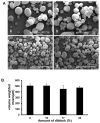
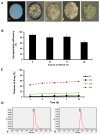
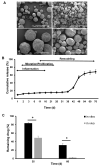
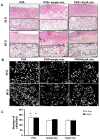
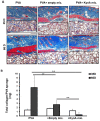

Similar articles
-
Novel, Blended Polymeric Microspheres for the Controlled Release of Methotrexate: Characterization and In Vivo Antifibrotic Studies.Bioengineering (Basel). 2023 Feb 27;10(3):298. doi: 10.3390/bioengineering10030298. Bioengineering (Basel). 2023. PMID: 36978688 Free PMC article.
-
The characterization of paclitaxel-loaded microspheres manufactured from blends of poly(lactic-co-glycolic acid) (PLGA) and low molecular weight diblock copolymers.Int J Pharm. 2007 Sep 5;342(1-2):6-17. doi: 10.1016/j.ijpharm.2007.04.022. Epub 2007 May 3. Int J Pharm. 2007. PMID: 17555895
-
Raloxifene-/raloxifene-poly(ethylene glycol) conjugate-loaded microspheres: A novel strategy for drug delivery to bone forming cells.Int J Pharm. 2016 Aug 20;510(1):168-83. doi: 10.1016/j.ijpharm.2016.06.053. Epub 2016 Jun 23. Int J Pharm. 2016. PMID: 27343363
-
Sustained delivery of vascular endothelial growth factor using a dextran/poly(lactic-co-glycolic acid)-combined microsphere system for therapeutic neovascularization.Heart Vessels. 2019 Jan;34(1):167-176. doi: 10.1007/s00380-018-1230-5. Epub 2018 Jul 24. Heart Vessels. 2019. PMID: 30043157
-
Characterization of perivascular poly(lactic-co-glycolic acid) films containing paclitaxel.Int J Pharm. 2004 Sep 28;283(1-2):97-109. doi: 10.1016/j.ijpharm.2004.06.025. Int J Pharm. 2004. PMID: 15363506
Cited by
-
Modelling and targeting mechanical forces in organ fibrosis.Nat Rev Bioeng. 2024 Apr;2(4):305-323. doi: 10.1038/s44222-023-00144-3. Epub 2024 Jan 18. Nat Rev Bioeng. 2024. PMID: 39552705 Free PMC article.
-
Engineered Microenvironments for 3D Cell Culture and Regenerative Medicine: Challenges, Advances, and Trends.Bioengineering (Basel). 2022 Dec 22;10(1):17. doi: 10.3390/bioengineering10010017. Bioengineering (Basel). 2022. PMID: 36671589 Free PMC article.
-
Novel, Blended Polymeric Microspheres for the Controlled Release of Methotrexate: Characterization and In Vivo Antifibrotic Studies.Bioengineering (Basel). 2023 Feb 27;10(3):298. doi: 10.3390/bioengineering10030298. Bioengineering (Basel). 2023. PMID: 36978688 Free PMC article.
-
A Review of the Health Benefits of Food Enriched with Kynurenic Acid.Nutrients. 2022 Oct 8;14(19):4182. doi: 10.3390/nu14194182. Nutrients. 2022. PMID: 36235834 Free PMC article. Review.
-
The Biology and Biochemistry of Kynurenic Acid, a Potential Nutraceutical with Multiple Biological Effects.Int J Mol Sci. 2024 Aug 21;25(16):9082. doi: 10.3390/ijms25169082. Int J Mol Sci. 2024. PMID: 39201768 Free PMC article. Review.
References
LinkOut - more resources
Full Text Sources
Miscellaneous

